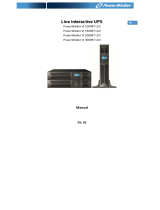
7
Introduction
The information provided in this manual covers single phase 700 – 3000 VA, uninterruptible power
systems, their basic functions, operating procedures, and emergency situations, also including information
on how to ship, store, handle and install the equipment. Only detailed requirements of the UPS units are
described herein, and installation must be carried out in accordance with this manual. Electrical
installations must also carefully follow local legislation and regulations. Only qualified personnel should
conduct these installations as failure to acknowledge electrical hazards could prove to be fatal.
System description
Several different kinds of sensitive electrical equipment stay protected by a UPS (Uninterruptible Power
System) including computers, workstations, process control systems, telecommunications systems, sales
terminals, other critical instrumentation, etc. The purpose of the UPS is to protect these systems from
poor quality utility power, complete loss of power, or other associated problems.
Electrical interference abounds in many forms causing problems in AC power, from lightning, power
company accidents and radio transmissions to motors, air conditioners, and vending machines, among
others. So protection of sensitive electrical equipment is vital to protect against power outages, low or
high voltage, slow voltage fluctuations, frequency variations, differential and common-mode noises,
transients, etc.
In order to prevent power line problems reaching critical systems causing damage to software, hardware
and causing equipment to malfunction, the UPS helps by maintaining constant voltage, isolating critical
load output if needed, and cleaning the utility AC power.





















